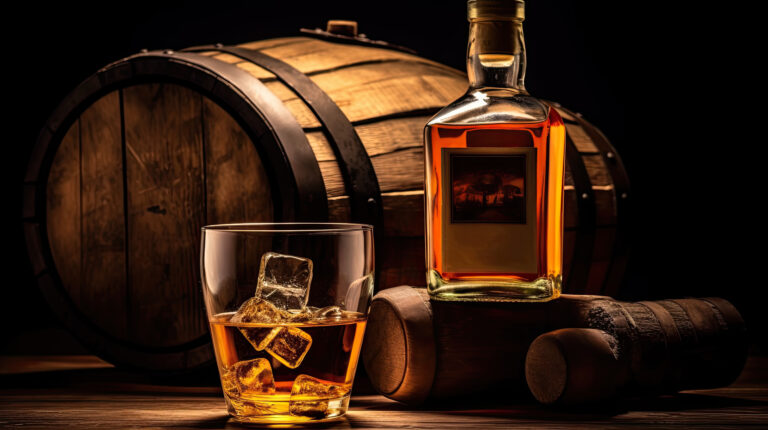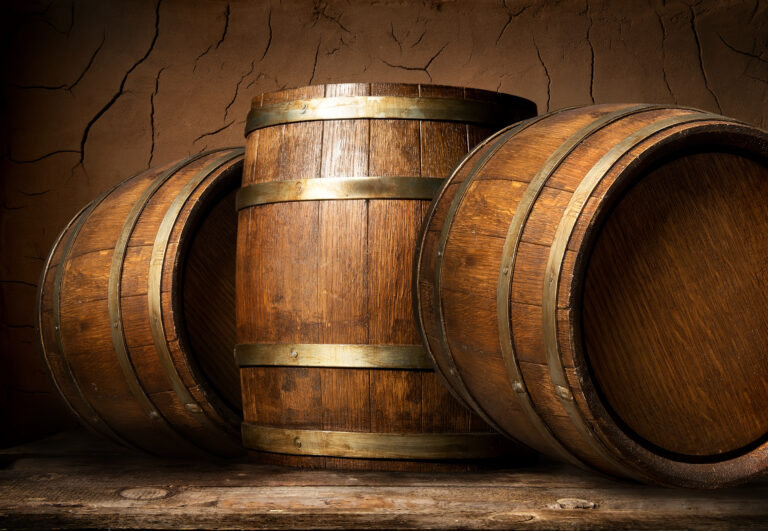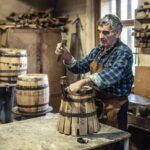Have you ever wondered why your favorite aged whiskey tastes so incredibly good? It’s not just magic; there’s a fascinating process behind it called barrel rolling, and it plays a huge role in developing those rich, complex flavors you love. As a whiskey enthusiast, you already know that time in an oak barrel is essential, but what if I told you that regularly rotating those barrels, or barrel rolling, is truly the secret sauce for maximizing taste?
Barrel rolling exposes the whiskey to different levels of oxygen and allows it to pull out more incredible compounds from the wood. The result? A smoother, more mellow taste, brimming with notes of vanilla, caramel, and spice. Let’s dive into the science and artistry of barrel rolling and discover why it makes such a significant difference in crafting a truly premium aged whiskey. This quick guide will give you an insider’s look and a newfound appreciation for every sip.
What Is Barrel Rolling?
Barrel rolling is simply the act of periodically rotating whiskey barrels as they age. Think of it like a gentle tumble, ensuring every drop of that precious liquid gets its fair share of the charred oak. As whiskey matures, it soaks in the unique flavors and aromas from the wood. By rotating the barrels, the whiskey comes into contact with fresh sections of the barrel, allowing it to extract even more intricate and nuanced flavors.
Most distilleries will rotate or roll barrels at least once during the aging process, with some doing it multiple times. Generally, the more often barrels are rolled, the more complex the resulting flavor can be. However, there’s a delicate balance; too much rolling can lead to over-oaking, where the whiskey takes on an undesirable bitter, tannic quality.
Beyond flavor extraction, barrel rolling helps ensure remarkable consistency between barrels. It exposes the whiskey to similar wood conditions across the entire batch. It also aids in more even maturation, especially since individual barrel staves (the wooden planks that make up the barrel) can vary in wood character and toast level. This practice is truly an art form, one that master distillers have honed over generations.
When executed properly, barrel rolling profoundly impacts the aroma, taste, mouthfeel, and finish of aged whiskey. Those subtle flavors imparted by the wood, like vanilla, caramel, and spice, become more pronounced. Tannins form and break down, creating a beautiful balance. Ultimately, barrel rolling helps create a harmonious marriage between the wood and the spirit.
The precise details of a distillery’s barrel rolling program are often closely guarded secrets, almost like a family recipe. But when you savor the results in a glass of finely aged whiskey, it’s undeniably clear that barrel rolling is a cornerstone of the aging process. The patience and skill required to properly mature whiskey is a true craft, and barrel rolling stands as one of the master distiller’s most vital tools for creating an exceptional aged spirit.
Why Barrels Are Rolled During Aging
Barrel rolling, or rotating barrels during the aging process, is absolutely crucial for developing those incredibly complex flavors in whiskey. As those barrels sit, the whiskey slowly soaks into the wood, drawing out compounds that impart distinct aromas and tastes. But here’s the kicker: not all parts of the barrel age the whiskey equally.
By rotating the barrels, you ensure the whiskey consistently makes contact with the entire inside surface of the barrel over time. The ends of the barrel, known as the heads, tend to age the whiskey faster than the middle section, often called the belly. Rolling the barrels exposes the whiskey to all these different aging zones, leading to more balanced and intricate flavors across the board.
As the whiskey ages, it penetrates deeper into the wood. The inner layers of the barrel contain compounds like vanillins that provide those lovely sweet, vanilla notes. Deeper layers hold tannins, which contribute spice and body. Barrel rolling allows the whiskey to draw from all these layers, producing a truly complex, multi-dimensional spirit.
Temperature also significantly impacts aging. Barrel rolling circulates the whiskey, ensuring it has equal contact with both warmer and cooler zones within the warehouse. This helps harmonize the aging process and prevents any single flavor from dominating the profile.
Whether you’re aging bourbon, Scotch, rum, or tequila, barrel rolling is a simple technique with a massive impact on the final product in your glass. All these little details combine to create a perfectly aged, richly-flavored spirit. So here’s a toast to the cooperages and distillers who pay such meticulous attention to their barrels – your patience and hard work truly don’t go unnoticed! The results, my friends, are definitely worth savoring.
How Often Barrels Are Rolled
As whiskey ages in those precious barrels, barrel rolling becomes a critical part of the journey. This process, also known as barrel rotation, involves physically turning the barrels. Typically, distillers will give each barrel a quarter turn every few months. This practice is key to ensuring the whiskey ages uniformly, especially since individual barrel staves can have slight differences.
Rolling the barrels achieves a few important things. First, it allows the whiskey to interact with more of the barrel surface area. Since the barrel wood imparts so much flavor to the whiskey, exposing it to more wood leads to a richer, more complex flavor profile.
Second, barrel rolling helps reduce temperature gradients inside the barrel. As seasons change, so does the barrel’s internal temperature. Rolling the barrel allows the whiskey’s temperature to equalize, preventing uneven aging. Distillers aim for uniform aging, not faster maturation on one side of the barrel.
Finally, barrel rolling helps prevent the whiskey from becoming too oaky. If the whiskey remains in prolonged contact with the same wood staves for too long, it can become over-oaked, leading to undesirable bitter notes. Gentle barrel rotation skillfully avoids this issue.
The frequency of barrel rolling depends on several factors, including barrel size, warehouse conditions, and the master distiller’s preferences. Larger barrels tend to be rolled less frequently, while smaller barrels might be rolled every 2-4 months. Generally, most distillers will rotate barrels at least 2-3 times during the first year of aging and then 1-2 times per year thereafter.
The next time you enjoy a glass of aged single malt or bourbon whiskey, take a moment to appreciate the incredible care and craftsmanship that went into its aging. Barrel rolling, when done properly, leads to a harmonious whiskey where the wood notes are perfectly balanced and integrated. And that, my friends, truly makes all the difference.
The Effects of Rolling on Whiskey Extraction
The effects of barrel rolling on whiskey during aging are truly significant. As the barrel gently spins, the liquid inside gracefully sloshes around, exposing even more of its surface area to the wood. This increased exposure means more whiskey can be absorbed into the wood, and in turn, more of those incredible wood compounds and flavors can be extracted into the whiskey.
More Wood Flavors
With each roll, the whiskey soaks into the wood a little deeper, drawing out those classic vanilla, caramel, and oak flavors. The gentle sloshing also brings more oxygen into contact with the whiskey, subtly accelerating the aging process and unlocking new dimensions of taste.
Smoother, Rounded Flavor
Barrel rolling is a key player in creating a smoother, more rounded flavor profile. The constant, gentle motion blends all the individual compounds together into a beautifully harmonious whole. Without this deliberate rotation, the whiskey can develop unevenly, with some areas of the barrel imparting more concentrated flavor than others.
Deeper Amber Color
As the whiskey soaks further into the wood, it naturally absorbs color compounds that give aged whiskey its distinctive deep amber hue. More time exposed to the wood, facilitated by rolling, means a darker, richer color in your glass.
Barrel rolling might seem like a simple process, but its effects are truly dramatic. While not every distillery employs barrel rolling, those that do often find their whiskeys develop superior depth, complexity, and character over time. This motion acts as a catalyst for the chemical reactions between the wood and the spirit, creating the signature flavor of aged whiskey. For the true whiskey connoisseur, a bottle from a rolled barrel offers a special taste of terroir in every sip.
Impact on Color and Flavor Development
Barrel rolling, also known as barrel rotation, is a fundamental practice in whiskey aging aimed at maximizing both flavor and color development. As the whiskey dances with the charred oak barrel during maturation, barrel rolling ensures even exposure to all those essential barrel staves.
Color
The whiskey naturally draws compounds like vanillin, lactones, and tannins from the wood, which are responsible for imparting both desirable flavors and that signature amber color. By rotating the barrel, the whiskey comes into contact with more of the wood’s surface area, absorbing more of these compounds and developing a richer, deeper color. Without rotation, barrels can lead to an uneven color distribution in the final product, which no one wants in their glass.
Flavor
Beyond color, barrel rolling significantly enhances flavor development. The whiskey extracts flavors from the wood’s lignin, hemicellulose, and oak lactones, as well as from the crucial char layer. Vanillin, in particular, contributes those beloved aromas of vanilla, caramel, and butterscotch. Rotating the barrels exposes the whiskey to more of these precious flavor compounds, resulting in a more complex, robust taste experience.
Oxidation
As oxygen interacts with the whiskey during aging, remarkable chemical reactions occur that alter its composition and produce highly desirable flavors, such as sherry or dried fruit notes. Barrel rolling thoughtfully increases oxidation by exposing more surface area of the whiskey to oxygen, especially as subtle temperature and pressure changes cause small amounts of air to enter and exit the barrel. This controlled additional oxidation accelerates the aging process and the development of truly mature, complex flavors.
Consistency
By rotating barrels during aging, distillers can achieve much better consistency between barrels and across different batches. The rotated barrels will age in a similar fashion, absorbing compounds and undergoing oxidation at comparable rates. This leads to a beautifully consistent flavor profile and quality across all bottles, even from different barrel lots. Non-rotated barrels, on the other hand, are much more prone to undesirable variability.
In essence, barrel rolling is a simple yet profoundly impactful practice that significantly elevates the quality of aged whiskey. By maximizing contact between the whiskey and the oak barrel, barrel rotation yields a spirit with superior color, flavor, aroma, and consistency. All of these factors come together to create an exceptionally smooth and complex final product that delights the senses.
Potential Drawbacks of Over-Rolling Barrels
While barrel rolling is generally beneficial for whiskey aging, like many good things, too much can actually be detrimental. Over-rolling barrels can negatively impact whiskey in several significant ways:
Loss of Distinctive Flavors
Excessive barrel rolling can cause the whiskey to absorb too much of the oak flavors from the barrel, sadly masking the unique flavors inherent to that particular whiskey. The specific grains, yeast strains, and terroir that define a whiskey’s character can get lost behind an overwhelming amount of vanilla, caramel, and wood tannins. For whiskeys designed to highlight a distillery’s distinct style, over-oaking is definitely undesirable.
Harsher, More Bitter Taste
As whiskey interacts with the oak barrel over time, certain compounds naturally break down and transform into new molecules that impart bitterness. While a touch of bitterness can provide balance and complexity, too much can make a whiskey taste unpleasantly harsh and astringent. Over-rolling accelerates these chemical reactions, quickly leading to an imbalance. The whiskey may become unpleasantly bitter and rough, often requiring longer aging just to mellow and round out.
Loss of Balance
A truly well-made, thoughtfully aged whiskey should exhibit a beautiful balance among its aromas, flavors, and mouthfeel. Excessive barrel influence from over-rolling can disrupt this delicate balance, overemphasizing oak and barrel-derived notes while muting others. The end result is a whiskey dominated by a single flavor profile rather than a symphony of complementary notes. Subtlety and nuance are unfortunately lost.
Higher Alcohol Content
During aging, some of the whiskey’s alcohol and water naturally evaporate through the barrel, which gradually reduces the proof. Over-rolling accelerates this process due to increased barrel surface area exposure, leading to a greater loss of whiskey volume (often called the “angel’s share”). While a lower barrel entry proof is often desirable for flavor development, too much alcohol evaporation can over-concentrate the remaining compounds in the whiskey. This might then require the addition of water to bring the proof down and balance the flavor, which can sometimes dilute the whiskey’s character.
In moderation, barrel rolling undoubtedly benefits whiskey aging, but as with so many art forms, restraint and subtlety are true virtues in whiskey making. Over-manipulation rarely improves the final result. The key lies in finding that sweet spot where the barrel’s influence enhances the whiskey’s flavor rather than dominates it entirely.
Best Practices for Barrel Rolling
Barrel rolling is a crucial process used by whiskey distillers to enhance the flavor and aroma compounds in aged whiskey. As whiskey matures in charred oak barrels, it absorbs compounds from the wood that give aged whiskey its distinctive brown color and those wonderful oaky, vanilla-like flavors. However, the whiskey only comes into contact with specific parts of the inside of the barrel. This is where barrel rolling, also known as barrel rotation or barrel turning, steps in to ensure even exposure to the vital barrel wood.
To get the absolute most out of barrel rolling, follow these expert best practices:
- Roll barrels at least once during the first year of aging and then every 3-6 months thereafter. This helps the whiskey absorb flavor compounds evenly in the crucial early stages of aging and maintains that even exposure as it continues to mature.
- Roll the barrels slowly and carefully to avoid disturbing any sediment that forms. While some sediment in aged whiskey is normal and expected, too much can make the whiskey appear cloudy, which nobody wants.
- Roll barrels in opposite directions each time. Alternating directions helps ensure a truly even distribution of the whiskey inside the barrel.
- Keep meticulous records of when each barrel was last rolled. This is essential to ensure no barrel goes too long without being rolled, which could lead to uneven aging and a loss of quality.
- Consider rolling barrels more frequently for higher-proof whiskeys. The higher the alcohol concentration, the faster it will absorb compounds from the barrel wood. More frequent rolling helps prevent over-absorption of wood flavors.
- Roll barrels at warmer temperatures when possible. Just like with overall aging, barrel rolling is more effective at warmer temperatures due to increased activity of compounds. Of course, temperatures still need to be carefully controlled to ensure safe and optimal aging conditions.
By diligently following these best practices for barrel rolling, distillers and blenders can significantly improve the quality, flavor, and aroma of their aged whiskeys. The result is a smoother, more complex spirit that true whiskey connoisseurs will deeply appreciate.
How Distilleries Monitor Barrel Activity
Once the distillation process is complete, distillers become vigilant guardians, monitoring barrel activity closely throughout the entire aging process. As the whiskey intimately interacts with the barrel, its characteristics transform dramatically. Distillers regularly sample barrels to meticulously check on the progress and make crucial decisions that shape the final product.
They carefully evaluate the whiskey’s color, aroma, and taste to determine if it has reached its optimal maturity. The whiskey’s color naturally deepens as it ages, a result of extracting compounds from the charred oak barrel. Meanwhile, its aroma and flavor profiles develop beautifully, gaining those desired notes of vanilla, caramel, and spice.
Checking Alcohol Strength
Distillers also closely monitor the barrel’s alcohol strength, often referred to as proof, over time. As the whiskey ages, some of the alcohol evaporates through the barrel – a phenomenon charmingly known as the “angel’s share” – which naturally decreases the proof. If the proof drops too low, the whiskey might not have a long enough shelf life after bottling. Distillers can adjust this by either adding water to lower the proof or, in some cases, adding unaged whiskey to increase it.
Barrel expansion and contraction are also carefully monitored. Temperature changes cause the barrel staves to expand and contract, allowing the whiskey to absorb and release compounds from the wood. Samples are routinely drawn and rigorously analyzed to determine how these seasonal proof and flavor changes impact the whiskey’s maturity.
Once the master distiller determines the whiskey has reached its peak perfection, it’s either bottled as a single barrel or small batch whiskey. Alternatively, it may be artfully blended with other barrels to create a consistent flavor profile before bottling.
The immense care and attention distillers pour into monitoring barrels during aging is absolutely key to producing a premium, full-flavored whiskey. Meticulously tracking how a whiskey develops over years, or even decades, of aging requires a blend of both science and art. The end result, however, is always worth the wait.
The Impact of Barrel Rolling on Whiskey Aging FAQs
Ever wondered why distillers go to the trouble of rolling those heavy barrels? Barrel rolling, also known as barrel rotation, is a truly important part of the whiskey aging process. As barrels sit for years, the whiskey interacts with the wood and oxygen, gradually mellowing the spirit. Rolling the barrels helps ensure a remarkably even maturation.
What is barrel rolling?
Barrel rolling simply means rotating the barrels. As barrels age, distillers will typically roll each barrel a quarter turn every few months. This consistent rotation exposes all sides of the barrel to the same conditions inside the rickhouse (the barrel warehouse). If barrels aren’t rolled, the whiskey at the top and bottom of the barrel can actually age quite differently.
Why is barrel rolling important?
Rolling barrels leads to a smoother, more consistent product. Without barrel rolling, the whiskey at the top of the barrel is exposed to more oxygen and greater temperature variations. Conversely, the whiskey at the bottom is exposed to more of the barrel wood. Barrel rolling helps create an even, harmonious interaction between the whiskey and the barrel, ultimately leading to a beautifully integrated blend of flavors.
How often are barrels rolled?
There isn’t a rigid, set schedule for barrel rolling. Distillers will regularly check on their barrels and roll them when they deem it appropriate, typically every 3 to 6 months. Some distillers opt to roll barrels more frequently in the initial years of aging and then less often as the whiskey gets older. The ultimate goal is simply to ensure all sides of the barrel are exposed to consistent conditions.
Does barrel rolling impact flavor?
Absolutely! Barrel rolling is crucial for creating a balanced, well-rounded flavor profile. Without this rotation, the whiskey can develop uneven flavors at different levels within the barrel. For instance, the portion at the top might be lighter and more oaky, while the portion at the bottom could be heavier and spicier. Barrel rolling leads to a seamless integration of these flavors, resulting in a more complex yet harmonious spirit that sings on your palate.
So next time you savor an aged whiskey, take a moment to reflect on the immense care and craftsmanship that went into its production. Simple techniques like barrel rolling have a profound impact on developing both flavor and quality. Distillers painstakingly monitor barrels, rolling them at precisely the right times to create an exceptional, truly memorable spirit.
Final Thoughts
You’ve now got a solid understanding of how barrel rolling profoundly impacts the aging of whiskey. As those barrels are skillfully rotated, the whiskey inside is exposed to varying levels of oxidation and extraction, creating an undeniably more complex flavor profile. This crucial movement also allows the spirit to penetrate deeper into the wood, picking up characteristics utterly unique to that specific barrel.
While barrel rolling certainly demands more manual labor and can be an added expense, many distillers firmly believe the impact on the final quality is well worth the investment. The next time you swirl an aged whiskey in your glass, take a moment to ponder the incredible journey those liquid flavors have been on. A few deliberate rolls of the barrel can genuinely make all the difference, transforming good whiskey into something truly extraordinary.







